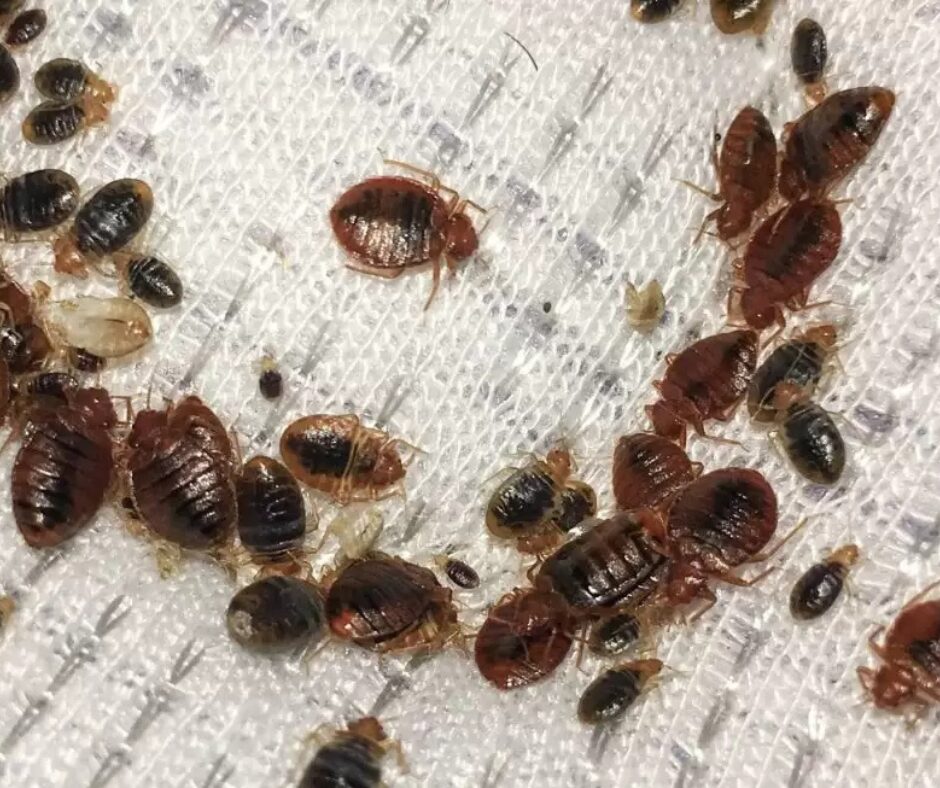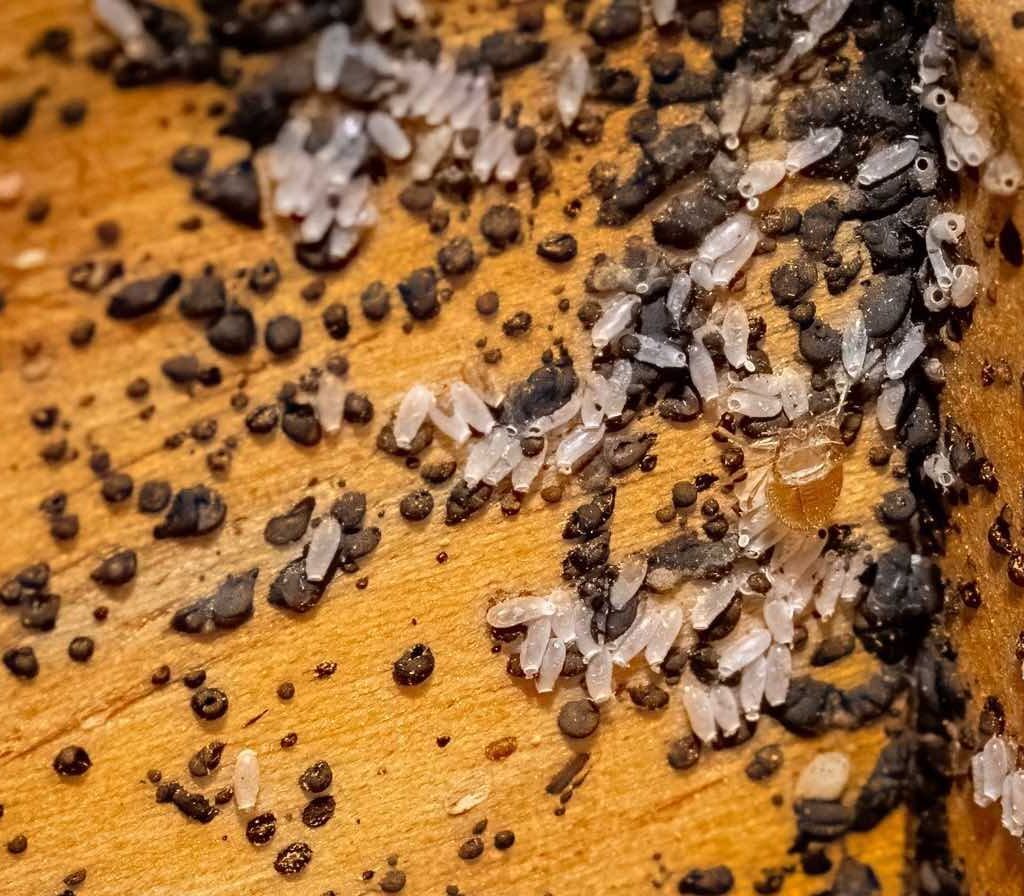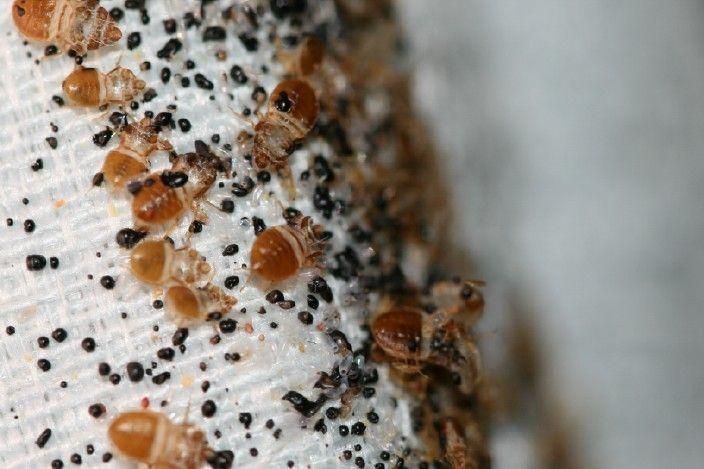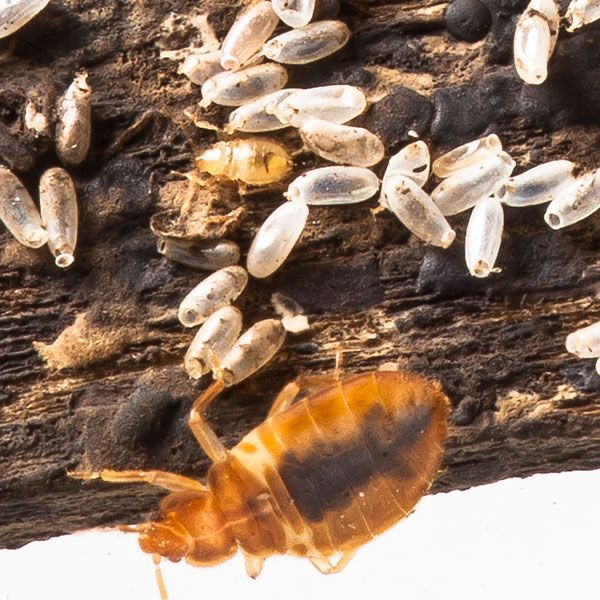Have you ever woken up with mysterious bites only to wonder where they came from? The truth is, bed bug infestations don’t appear overnight—they start small, with nearly invisible eggs tucked away in mattress seams, furniture cracks, or behind wall edges.
What seems like a minor nuisance can quickly spiral into a full-blown problem if those eggs are left to hatch and multiply.
Understanding how long it takes bed bug eggs to hatch and spread is crucial for both homeowners and property managers. Eggs can develop into biting pests in just over a week, and a single female can lay hundreds in her lifetime.
That’s why knowing the timeline isn’t just an interesting fact—it’s your first line of defense against an infestation.
In this guide, we’ll walk through the bed bug life cycle, explain how quickly eggs turn into adults, and share practical strategies for spotting and preventing the spread.
Whether you’re managing a single home or an entire property, this knowledge could save you time, money, and peace of mind.
Understanding how long it takes bed bug eggs to hatch and spread

To fully grasp how long it takes bed bug eggs to hatch and spread, it helps to start with the life cycle of these pests. Bed bugs go through three major stages: egg, nymph, and adult.
Each stage plays a role in how fast an infestation develops, which is why property managers and homeowners need to recognize the signs early.
- Egg stage – Bed bug eggs are tiny, pearl-white, and about the size of a pinhead. They are sticky when first laid, allowing them to cling to fabric, wood, or hidden crevices. This makes them incredibly difficult to spot without a trained eye.
- Nymph stage – After hatching, bed bugs enter the nymph stage, where they need blood meals to grow. They shed their skin five times before reaching adulthood.
- Adult stage – Fully grown bed bugs are reddish-brown, about the size of an apple seed, and can live several months while laying more eggs if they have access to food.
Understanding this progression is important because a single female can lay multiple eggs daily. Read more about how long it takes bed bug eggs to hatch and spread, setting the stage for exponential growth in just a few weeks.
How Long Does It Take Bed Bug Eggs to Hatch and Spread?
On average, bed bug eggs hatch within 6 to 10 days, depending on environmental conditions.
Warmer temperatures and steady access to a blood meal often speed up this process, while cooler or unstable conditions may delay hatching slightly.
For homeowners, this means that what looks like a clean mattress or tidy living space could already be harboring eggs that will hatch in less than two weeks.
For property managers, the concern is even greater. In multi-unit properties, once eggs hatch, nymphs can easily spread between apartments through electrical outlets, shared walls, or furniture. This makes early detection and action critical.
By the time adult bed bugs are visible, dozens of eggs may have already hatched, creating a cycle that is much harder to break.
Factors That Influence Hatching and Spread
Several factors determine how long it takes bed bug eggs to hatch and spread into a full infestation:
- Temperature: Eggs hatch more quickly in warm environments (around 70–90°F).
- Humidity: Moderate humidity levels support faster egg development.
- Food source: Regular access to blood meals allows nymphs to mature into adults faster, accelerating the cycle.
- Clutter and hiding spots: More places to hide mean eggs can be laid undisturbed, increasing survival rates.
For homeowners, maintaining a clean and uncluttered environment makes it harder for eggs to go unnoticed. For estate owners or managers, regular inspections across units are essential to reduce the risk of unnoticed hatching.
Why the Egg Stage Matters Most
Many people only start worrying about bed bugs once they see adults crawling around or experience bites. However, the egg stage is the most dangerous point of the cycle.
Once eggs hatch, nymphs spread quickly, and within weeks, a small cluster of eggs can turn into a widespread infestation.
This is especially concerning for property managers who oversee multiple residences. If even one tenant brings in bed bugs, eggs can spread throughout the property in less than a month.
This not only threatens tenant comfort but also damages the reputation and financial stability of the property.
By focusing on prevention and early detection at the egg stage, both homeowners and estate managers can stop infestations before they spiral out of control.
How Quickly Bed Bug Infestations Spread

When considering how long it takes bed bug eggs to hatch and spread, it’s important to recognize that the hatching stage is just the beginning.
What makes bed bugs especially troublesome is not just their ability to reproduce, but how quickly an unnoticed egg cluster can grow into a serious infestation.
The Reproductive Rate of Bed Bugs
A single female bed bug can lay up to five eggs per day and more than 200–500 eggs during her lifetime. Within just a week, those eggs hatch, and the newly emerged nymphs begin feeding almost immediately. Each nymph requires blood meals to advance through five growth stages before becoming an adult capable of laying more eggs.
This means that in as little as a month, one fertilized female can lead to hundreds of new bed bugs in a single property. For homeowners, that might mean waking up with unexplained bites.
For estate owners or property managers, it could mean multiple tenants reporting infestations within a short timeframe.
How Bed Bugs Move and Multiply
Unlike pests that can fly or jump, bed bugs crawl. However, they spread surprisingly fast due to human activity. Here are common ways infestations expand once eggs hatch:
- Between rooms or units: Bed bugs crawl through electrical outlets, cracks in walls, and baseboards.
- Through furniture and belongings: Infested mattresses, chairs, or couches moved from one unit to another can transfer eggs and nymphs.
- Via travel and visitors: Guests or tenants returning from infested hotels or public spaces can carry eggs in luggage or clothing.
- Shared laundry facilities: If clothing or bedding with eggs is washed without high heat, those eggs may survive and spread.
This is why knowing how long it takes bed bug eggs to hatch and spread is not just theoretical knowledge—it highlights how quickly a single oversight can create a widespread problem.
The Timeline of an Expanding Infestation

- Week 1–2: Eggs hatch, releasing nymphs that begin feeding.
- Week 3–4: Nymphs grow into adults if blood meals are available.
- Month 2: Multiple adults are laying new eggs, compounding the infestation.
- Month 3+: Without intervention, populations can number in the thousands, making eradication extremely difficult and costly.
For property managers, they usually underestimate how long it takes bed bug eggs to hatch and spread this rapid timeline underlines the importance of proactive inspections. For homeowners, it’s a reminder that even a few bites should not be ignored—bed bug eggs may already be hatching and spreading.
Why Fast Action Matters
The key takeaway when discussing how long it takes bed bug eggs to hatch and spread is that the timeline leaves very little room for delay.
Eggs that hatch in under two weeks can lead to generations of bed bugs in only a few months. The earlier the problem is identified and addressed, the more manageable—and less expensive—it is to control.
For estate owners managing multi-unit complexes, a single missed inspection can mean widespread tenant dissatisfaction and higher extermination costs.
For homeowners, waiting even a few weeks can mean moving from a small, treatable infestation to one that requires professional intervention.
Early Signs of a Bed Bug Egg Infestation
One of the biggest challenges with bed bugs is that infestations often go unnoticed until they are well established. Recognising how long it takes bed bug eggs to hatch and spread helps property managers intervene before tenants face widespread infestations
Because the eggs are tiny and nearly invisible to the untrained eye, most homeowners and property managers only realize there is a problem once nymphs and adults are already spreading.
Knowing the early warning signs makes all the difference in catching an infestation before it becomes overwhelming.
What Bed Bug Eggs Look Like

Bed bug eggs are about 1 millimeter long, oval-shaped, and pearly white in color. They are often mistaken for grains of salt or dust particles, which is why they are easily overlooked.
Freshly laid eggs are sticky, allowing them to cling to hidden areas such as mattress seams, cracks in wooden furniture, or behind headboards.
When considering how long it takes bed bug eggs to hatch and spread, spotting these eggs early is critical. If they remain undisturbed, they can hatch in as little as a week, quickly escalating into a larger infestation.
Common Places to Find Bed Bug Eggs
Both homeowners and estate managers should routinely check for eggs in the following high-risk areas:
- Mattress seams, box springs, and bed frames
- Upholstered chairs, couches, and cushions
- Cracks in walls, floors, or wooden furniture
- Behind electrical outlets, baseboards, or wall hangings
- Inside drawers, closets, or luggage stored near sleeping areas
Regular inspections in these areas can help identify problems early, especially in properties where tenant turnover is frequent.
Other Signs of Bed Bug Activity
Eggs are not the only indicators of a growing infestation. Keep an eye out for:
- Rust-colored stains on sheets or mattresses from crushed bed bugs
- Dark spots that resemble ink stains (bed bug excrement)
- Shed skins from nymphs molting as they grow
- Clusters of bites on exposed skin, often appearing in lines or small groups
- A musty odor in severe infestations caused by bed bug scent glands
For estate owners and property managers, tenant complaints of bites or unexplained marks on skin should be taken seriously. These are often the first human-level signs that eggs have already hatched and are spreading.
Why Early Detection Matters
By the time adult bed bugs are visible, an infestation is usually well underway. Since how long it takes bed bug eggs to hatch and spread is a matter of days to weeks, delaying inspections or ignoring small signs can result in a rapid population boom.
For homeowners, acting quickly at the first sign of eggs or bites can prevent the need for expensive extermination. For property managers, proactive monitoring and responding swiftly to tenant concerns can protect both the property’s reputation and finances.
How to Control Bed Bug Eggs and Stop the Spread
Understanding how long it takes bed bug eggs to hatch and spread is only half the battle—the real key is knowing how to control them before they develop into a larger infestation.
Because eggs are small, sticky, and hidden in cracks or fabrics, eliminating them requires a combination of thorough cleaning practices and professional measures.
For Homeowners: Simple but Effective Steps
Homeowners facing the early stages of an infestation can use a few proven techniques to reduce the chances of eggs hatching and spreading:
- Vacuum thoroughly and frequently: Vacuuming regularly reduces the risk tied to how long it takes bed bug eggs to hatch and spread in furniture and carpets. Focus on mattresses, box springs, bed frames, and upholstered furniture. Dispose of the vacuum bag in a sealed plastic bag immediately after use.
- Use high heat treatments: Wash bedding, curtains, and clothing in hot water and dry them at the highest setting. Bed bug eggs cannot survive sustained high temperatures.
- Steam cleaning: Applying steam to mattresses, carpets, and furniture is an effective way to kill both eggs and live bed bugs hiding in seams or cracks.
- Mattress and pillow encasements: Special covers trap any eggs or bed bugs inside, cutting off their ability to spread further.
- Decluttering: Reducing clutter makes it harder for eggs to remain hidden and gives you a better chance of spotting early signs.
These steps do not guarantee complete elimination but are powerful tools for reducing the risk of eggs hatching and turning into an infestation.
For Estate Owners and Property Managers: A Systematic Approach
For property managers overseeing multiple units, the risk of infestations spreading from one apartment to another is far higher. Once you know how long it takes bed bug eggs to hatch and spread, a systematic prevention plan becomes essential.
Key strategies include:
- Regular inspections: Conduct routine checks of high-risk units, especially after tenants move out. Early detection saves both money and time.
- Professional pest control partnerships: Work with certified pest control providers who can use heat treatments, chemical options, or integrated pest management (IPM) strategies to destroy eggs and prevent re-infestation.
- Tenant education programs: Provide tenants with information about recognizing eggs and early warning signs. Tenants who understand the risks are more likely to report issues early.
- Isolation protocols: When bed bugs are detected, seal off affected units immediately and schedule treatment to prevent spread into neighboring apartments.
By combining professional expertise with preventive measures, estate managers can protect entire buildings from the costly and reputational damage that comes with large-scale infestations.
Why Control Measures Must Be Immediate
The short window of how long it takes bed bug eggs to hatch and spread—as little as 6–10 days—means there’s no time to waste once an infestation is suspected.
For homeowners, waiting a few weeks before acting can turn a manageable problem into one requiring professional extermination. For property managers, ignoring a single complaint could lead to infestations across multiple units, significantly raising treatment costs.
Key Prevention Tips
The best way to handle bed bugs is to stop them before they become a problem. Once you understand how long it takes bed bug eggs to hatch and spread, prevention becomes even more important.
Because eggs hatch in just over a week and infestations multiply rapidly, adopting proactive habits can save time, money, and stress for both homeowners and estate managers.
For Homeowners
Preventing bed bugs in the home starts with everyday habits. Training tenants on how long it takes bed bug eggs to hatch and spread ensures faster reporting and minimizes long-term costs for property owners.
Simple steps can dramatically reduce the risk of eggs being introduced or allowed to develop unnoticed:
- Inspect second-hand furniture: Bed bug eggs are often hidden in used couches, beds, and chairs. Always check seams and joints carefully before bringing items inside.
- Use protective encasements: Mattress and pillow encasements make it harder for bed bugs to hide and easier to detect infestations early.
- Wash and dry fabrics on high heat: Regularly wash bedding, curtains, and travel clothing at high temperatures to kill any eggs.
- Reduce clutter: Fewer hiding spots make it harder for eggs to survive undetected.
- Stay alert after travel: Inspect luggage, clothing, and personal items after staying in hotels or shared accommodations.
By building these habits into regular home care routines, and with knowledge onRead more about how long it takes bed bug eggs to hatch and spread, homeowners can significantly reduce the chance of eggs hatching into full-blown infestations.
For Property and Estate Managers
Multi-unit properties are at a higher risk because infestations can spread quickly from one tenant to another. Exterminators often explain how long it takes bed bug eggs to hatch and spread to help clients understand why follow-up treatments are necessary
Knowing how long it takes bed bug eggs to hatch and spread means you can design policies that address problems early. Effective strategies include:
- Routine inspections across units: Especially important during tenant turnover, when hidden eggs may remain after move-out.
- Integrated Pest Management (IPM): Partnering with pest control experts who combine chemical treatments, heat solutions, and monitoring systems.
- Tenant awareness programs: Distributing information on how to recognize eggs, signs of bed bugs, and the importance of early reporting.
- Containment protocols: Isolate affected units immediately and treat surrounding spaces to prevent infestations from spreading.
A Preventive Mindset
The critical fact about how long it takes bed bug eggs to hatch and spread—just 6–10 days—makes prevention non-negotiable. For homeowners, this means regular vigilance.
For property managers, it means building preventive measures into operational policies. Acting before the eggs hatch is always easier and far less costly than trying to control an infestation once it has spread.
Conclusion
Bed bugs may be small, but the damage they cause grows quickly. Now that you know how long it takes bed bug eggs to hatch and spread—just a matter of days—it’s clear why early action is so critical.
From understanding the life cycle to spotting early signs, controlling eggs, and putting prevention measures in place, both homeowners and property managers can stay one step ahead of these stubborn pests.
Don’t wait until a few hidden eggs become a costly, stressful infestation. Make vigilance part of your routine, and take the lessons you’ve learned here to protect your home or property.
Now that you understand how long it takes bed bug eggs to hatch and spread, subscribe to our blog for more practical guides and follow us on social media for timely pest control updates.
And by sharing, you’re helping more homeowners and managers protect their spaces from infestations before they start.